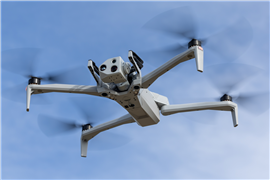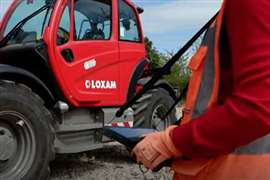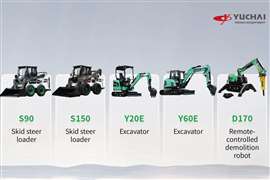Access OEMs discuss how the MEWP market will evolve in 2022
02 December 2021
Demand for manually propelled MEWPs has steadily increased over the last few years due to jobsite requirements, discontinued use of ladders and machine advancements. ALH reports.
What once might have been considered a niche market, the push-around sector is growing in popularity due to a number of jobsite and safety factors. We asked manufacturers what’s driving demand, what buyers should consider before making a purchase and how they see the 2022 market fairing. Here’s what they had to say.
ALH: How has the push-around MEWP market changed/evolved over the last two years?
Justin Kissinger, Hy-Brid Lifts, marketing manager: In recent years, we have seen an increase in the use of push-around scissor lifts as an alternative to ladders. This trend is driven by an increased focus on reducing safety hazards and injuries on the jobsite. Hy-Brid Lifts push-around scissor lifts meet rigorous industry safety standards and include features like a non-slip deck, tilt alarm, bumpers and railings that help to reduce the risk of falls on jobsites. In addition to the safety benefits, push-around scissor lifts can be easily maneuvered on jobsites and increase efficiency with a platform where users can keep work materials nearby.
 Hy-Brid Lifts push-around scissor lifts meet rigorous industry safety standards, according to marketing manager Justin Kissinger.
Hy-Brid Lifts push-around scissor lifts meet rigorous industry safety standards, according to marketing manager Justin Kissinger.
Misty Mason, JLG, product manager for low-level access and verticals: Popularity has been increasing for push-around lifts over the past few years. This growth is driven by applications where workers might have once used ladders and scaffolding. That’s because more and more companies are looking for safer ways to work at height.
Another driver behind the growth is urbanization. With less open space, and buildings getting taller and narrower, there is a greater need for products that have a small footprint, are lighter weight for use on sensitive flooring, that can fit into in elevators and can be moved between floors for finish and fit out construction work or ongoing maintenance.
As demand grows for low-level access MEWPs, JLG has expanded its line to include the EcoLift 50 and EcoLift 70 human-powered lifts, as well as the 830P and 1030P push-around lifts.
Matthew Elvin, Snorkel, CEO: In terms of push-around low-level access products, such as the Snorkel mini scissor lifts, this market is continuing to grow as more contractors adopt low-level access products over traditional methods such as step ladders and podiums. The adoption of these products is happening more rapidly in high density, urban areas, such as major cities and metropolitan areas where there are a greater number of high-rise construction projects.
In terms of push-around mast lifts, this market has remained fairly stable, as these products are often purchased by large facilities for maintenance applications, such as in atriums, office complexes, shopping malls, hotels and resorts. In certain applications, some users are moving towards spider lifts for these jobs due to their ultra-compact dimensions and mobility capabilities, however, spider lifts are a more expensive and more complex option than push-around mast lifts, which may be beyond the requirements of some users.
ALH: What advancements have been made to push-around MEWPs that help to improve productivity?
Kissinger: Our push-around scissor lifts offer add-on features such as tool trays and part holders to help users keep their materials organized and close at hand. The lifts can also have USB ports for convenience, improved rear casters, and see-through front boards for better visibility.
Mason: Advancements in push-around MEWPs have been focused on enhancing the operator’s experience through productivity-focused features, such as the inclusion of tool trays for the convenient storage of tools at height, the addition of saloon style doors and a step for easy access into and out of the platform. And in the case of the JLG EcoLift Series, the development of a patented stored-powered lift/lower system eliminates the need to charge a battery during or between shifts.
Low-level lifts are also designed to reduce strain on the body and lessen the risk of musculoskeletal injuries caused by repetitive movements, such as climbing up and down a ladder.
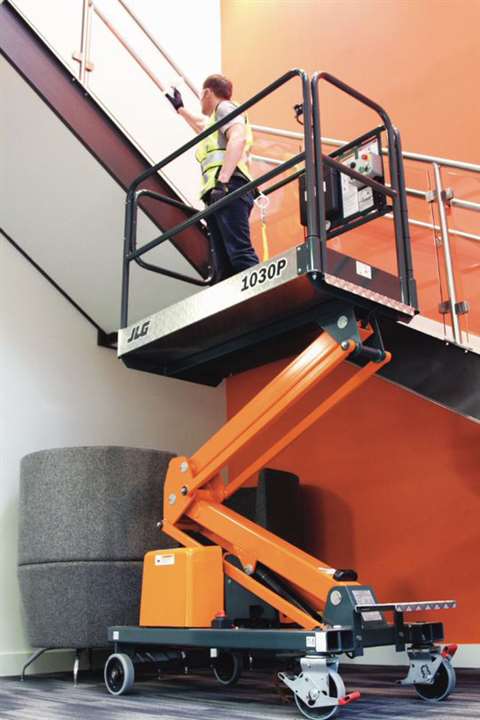 The size and weight of low-level access lifts make them particularly suited to multi-story construction applications.
The size and weight of low-level access lifts make them particularly suited to multi-story construction applications.
Elvin: By default, push-around low-level scissor lifts offer productivity benefits over traditional methods such as step ladders, podiums and scaffolding towers. The size and weight of the low-level access lifts make them particularly suited to multi-story construction applications, as they can be brought onto the project at the start, and can be easily carried in elevators to the next levels as they are constructed, enabling various tradespeople to safely use them for overhead installation work.
A spacious platform and generous lift capacity enable the operator to carry the necessary tools and materials to the working area, minimizing the lift/lower frequency and improving productivity. On many jobsites, workers will actually take ownership of a push-around mini scissor lift and use it to transport their tools and equipment as they push the unit between working areas.
From a safety perspective, there are many advantages to using low-level access over traditional methods. For example, unlike a ladder, a push around mini scissor lift has a single step to enter and exit the platform reducing the risk of trips or falls and reducing operator fatigue. Additionally, the lift has integral guardrails to protect the operator from falls, and the Snorkel models are equipped with saloon-door style entry gates which swing closed automatically after entry to the platform.
ALH: What are some top tips/factors customers should consider when choosing to purchase a push-around MEWP?
Kissinger: It’s important to consider portability and whether the scissor lift is light enough for operators to physically push it around a jobsite or load onto the back of a pick-up truck to transport to different locations. The size of the wheels can also determine how easy it will be to push around on a jobsite.
Platform size and weight capacity are also important factors to keep in mind. Customers should think about what tools and materials a user will bring with them on the scissor lift to complete a job. The size and weight of these items will determine how much space the user will need and how much weight the scissor lift will need to handle.
With our industry-leading, high-capacity scissor lifts, the new ANSI load sensing restrictions still allow us to provide lift options that meet heavy load requirements. Where other manufacturers kept the same load restrictions they had in place, we were able to provide increased capacity to bring more materials on the scissor lift without overloading the platform. Our scissor lifts keep operators safe and productive with the ability to carry more materials at one time and reduce delays on the job from platform overload.
Zach Gilmor, Genie, product manager: As facility owners and jobsites continue to emphasize fall prevention, use of ladders is frequently being discouraged. As a result, there is a growing need for lightweight, productive machines. This is driving demand for both manually propelled MEWPs, as well as self-propelled MEWPs that can get into restricted access applications with low floor loading requirements.
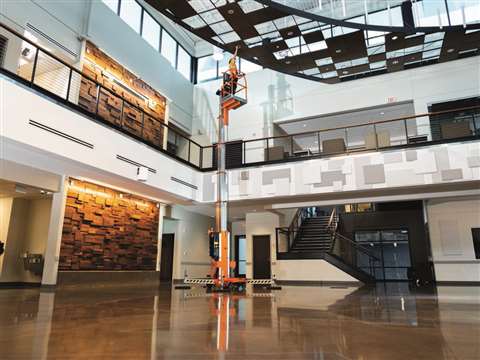 The push-around sector is growing in popularity due to a number of jobsite and safety factors.
The push-around sector is growing in popularity due to a number of jobsite and safety factors.
In addition to floor loading, operators must consider the aerial access requirements, including maximum platform or working height, required occupants and capacity, as well as whether the application is indoors or outdoors. Another important consideration when selecting a MEWP is how the unit will access the jobsite — including whether the unit must be moved via elevator, as the capacity requirements or size of doors may restrict usage to more compact machines.
Mason: As with any equipment selection, when choosing a push-around MEWP, owners or renters should consider the work to be done, including the height requirements of the job and the capacity that the lift will need to support, including the personnel, materials and tools that will be needed when elevated. Other key specifications to know are the maximum platform height, maximum working height and weight of the machine.
Other factors to consider are the constraints of the work area, such as narrow doorways, elevators, sensitive flooring and/or noise and emissions sensitivity. Also, it is important to know whether the machine will be working indoors or out, as many low-level access lifts are only rated for indoor use.
Elvin: While most push-around models are designed for indoor use and to fit through standard doorway, customers should always check the stowed dimensions and overall weight of the push-around unit to ensure that the machine can access the intended areas, and can fit in the available storage area between uses. The maximum working height of the unit also needs to be evaluated to ensure it will reach the desired work area, and that the platform capacity will be suitable for any materials or tools that need to be carried.
A critical consideration is also the wind rating of the unit. Most push-around access equipment is designed for indoor use only with zero wind rating. This means that the equipment should only be used in fully enclosed areas, which may mean that the lift cannot be used early in a construction project, for example. Some manufacturers, including Snorkel, are now offering outdoor-rated push-around lifts, which can be used in such environments.
ALH: How do you see the push-around market fairing in 2022?
Kissinger: At Hy-Brid Lifts, we are seeing a strong demand that we expect to continue through the upcoming year. Companies looking to purchase push-around scissor lifts should prepare for extended lead times as lift manufacturers are seeing strong demand for production.
Mason: We anticipate that demand for these types of lifts will continue to grow as companies place more focus on replacing ladders and scaffolding in the workplace. They will also gain favor among companies focused on eco-friendly solutions and sustainability.
Elvin: We anticipate that the push-around scissor lift market will remain fairly stable in 2022, possibly with some growth from the impact of campaigns, such as Ladders Last. In the push-around mast lift segment, we expect this to remain in line with 2021 as these lifts are mostly sold to owner-operators, and we see a fairly consistent level of demand for both new user sales as well as replacement.
STAY CONNECTED



Receive the information you need when you need it through our world-leading magazines, newsletters and daily briefings.
CONNECT WITH THE TEAM










